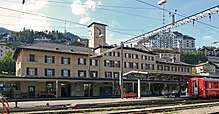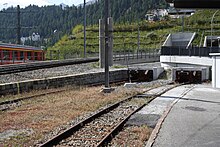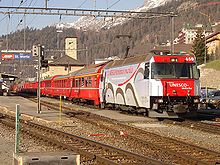St. Moritz train station
The St. Moritz train station is the train station in the health resort of St. Moritz in the Upper Engadine in the canton of Graubünden . It is operated by the Rhaetian Railway and is located 1775 m above sea level on the north-western slope of the valley directly above Lake St. Moritz at the outflow of the Inn .
It is the terminus of the Albula Railway and the Bernina Railway . Since these are operated with different power systems, it is also a system transfer station.
history
The St. Moritz tram opened on July 5, 1896 ; it ceased operations in 1932 and was replaced by buses. The early discontinuation was also due to the fact that it did not open up the station that was subsequently opened and the changeover was cheaper than building a branch line. For the resulting local bus service, the bus stop at the train station, together with the other bus lines, forms a hub of the entire bus network in the Upper Engadine.
The Albula Railway was opened in 1903, but the last section from Celerina to St. Moritz did not go into operation until July 10, 1904. The St. Moritz – Celerina Staz line on the Bernina Railway was opened on July 1, 1909.
The station was built as a through station, as an extension of the line towards Maloja was initially planned. A track led from the west side of the station first over a bridge and then almost into the slope. At this point the portal of a tunnel was planned, which should pass under the center of St. Moritz.
With a view to the 2017 Ski World Cup in St. Moritz, the station was expanded between 2014 and 2017 to become a terminal station with rail-free access and a cross platform. The new, covered platforms on five platform tracks are handicapped accessible. The station building remained unchanged, while the station square was redesigned with a bus terminal. The goods shed is used for the railway's own use. The RhB had to have a 250 m long retaining wall built along the cantonal road for the various new sidings.
Structural matters
The stately reception building is located on the mountain side of the track system and has a house platform. There is also a central platform for trains in the RhB mainline network and another for trains on the Bernina Railway . To the east of the reception building is the goods shed with a ramp, another open loading ramp is in the eastern section of the station between the two route exits. There are also extensive parking facilities.
Immediately after the train station, the Bernina Railway runs over the Inn Bridge and shortly afterwards into the 689 m long Charnadüra Tunnel II. Under the railway bridge, a road bridge leads across the Inn at another intersecting angle. The Albula line goes through the 114 m long Argenteri tunnel immediately after the train station and shortly afterwards through the 448 m long Charnadüra tunnel I.
The first station building was designed by A. Ludwig, who was also the site manager. The construction costs are given as 90,000 CHF. The building was built by the builder Huder from Davos . Because of the harsh climate and the very high wood prices at the time, the building consisted of plastered rubble stones. It was a three-part building with two raised end structures connected to a low central building. The building was replaced by the current structure in 1927.
Operational
The station is operationally divided into two parts, as the two lines are operated with different electricity systems. The Albulabahn , which is part of the main RhB network , is electrified with 11 kV 16⅔ Hz alternating current, while the Bernina Railway is electrified with 1 kV direct current. For this reason, diesel- powered shunting vehicles are stationed for shunting maneuvers .
The timetable consists of an hourly InterRegio IR via the Albula Railway to Chur and an hourly regional train R to Pontresina , which usually continues to Tirano . The IR have in Samedan connection to the trains to the Lower Engadine. In addition, RegioExpress RE operate to Zernez (- Vereinatunnel -) Klosters - Landquart. The train station is the official start and end point of the Glacier Express . The railcars that run the Bernina Express also start and end here, while the panorama cars to and from Chur / Davos are pulled by an ABe 8/12 “Allegra” twin-current multiple unit and go directly to Pontresina.
The bus lines that enable the Upper Engadin to be developed also stop at the St. Moritz Bahnhof stop.
Web links
Individual evidence
- ↑ St. Moritz station at rhb.ch, accessed on February 19, 2017
- ↑ Equipped for the World Ski Championships in: LokMagazin 3/2017, p. 28
- ^ Werner Stutz: Railway stations in Switzerland from the beginnings to the First World War , Orell Füssli 1983 ISBN 3-280-01405-0
Coordinates: 46 ° 29 '52.6 " N , 9 ° 50' 47" E ; CH1903: seven hundred and eighty-four thousand eight hundred ten / 152462



